

Organized crime / Organized crime / Crime areas. Definitions of what constitutes organized crime vary widely from country to country.
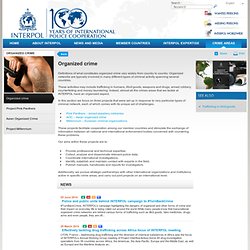
Organized networks are typically involved in many different types of criminal activity spanning several countries. These activities may include trafficking in humans, illicit goods, weapons and drugs, armed robbery, counterfeiting and money laundering. Indeed, almost all the crimes areas that we tackle at INTERPOL have an organized aspect. In this section we focus on three projects that were set up in response to very particular types of criminal network, each of which comes with its unique set of challenges. These projects facilitate cooperation among our member countries and stimulate the exchange of information between all national and international enforcement bodies concerned with countering these problems.
Drug Trafficking and Organized Crime in the Americas: Major Trends in the Twenty-First Century. Trends in Organized Crime. Copyright Information For Authors Submission of a manuscript implies: that the work described has not been published before (except in form of an abstract or as part of a published lecture, review or thesis); that it is not under consideration for publication elsewhere; that its publication has been approved by all co-authors, if any, as well as – tacitly or explicitly – by the responsible authorities at the institution where the work was carried out.

Author warrants (i) that he/she is the sole owner or has been authorized by any additional copyright owner to assign the right, (ii) that the article does not infringe any third party rights and no license from or payments to a third party is required to publish the article and (iii) that the article has not been previously published or licensed. The author signs for and accepts responsibility for releasing this material on behalf of any and all co-authors. Author is requested to use the appropriate DOI for the article. For Readers. Recent Trends in the Study of Transnational Organized Crime. 3the illegal cigarette trade (Antonopoulos & van Duyne 2009; Beare 2002; Blecher 2010; Joossens & Raw 2008; LeGresley, Lee, Muggli & Patel 2008; Shen, Antonopoulos & vonLampe 2010; von Lampe, Kurti, Shen & Antonopoulos 2012).
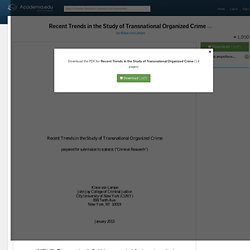
A number of othertransnational crimes are addressed more sporadically, such as trafficking in stolen motorvehicles (see, e.g., Gounev & Bezlov 2008), trafficking in stolen arts and antiquities (see, e.g. ,Bowman 2008), trafficking in protected wildlife (see, e.g., Wyatt 2009) and other naturalresources (see, e.g., Bisschop 2012), trafficking in arms (see, e.g., Cook, Cukier & Krause2009), trafficking in nuclear material (see, e.g., Kupatadze 2007), illicit waste disposal (see,e.g., Massari & Monzini 2004), fraud (see, e.g., Ampratwum 2010), serial burglary (see, e.g. Data sources. Organized Crime and Cybercrime: By Phil Williams Organized Crime and Cybercrime: Synergies, Trends, and Responses Professor of International Security Studies, University of Pittsburgh and 2001-2002 Visiting Scientist at CERT/CC, a center of Internet security expertise at Carnegie Mellon University.
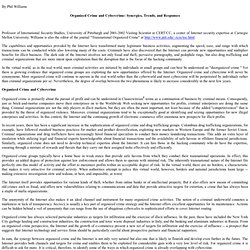
Williams is also the editor of the journal "Transnational Organized Crime" at The capabilities and opportunities provided by the Internet have transformed many legitimate business activities, augmenting the speed, ease, and range with which transactions can be conducted while also lowering many of the costs. Criminals have also discovered that the Internet can provide new opportunities and multiplier benefits for illicit business.
Transnational criminal organizations and drug traf... [Bull Narc. 1994] International Journal, Vol. 57, No. 4 (Autumn, 2002), pp. 513-536. Transnational Criminal Activity. November 1998 "Organized crime is the federal government's Number One law enforcement priority....
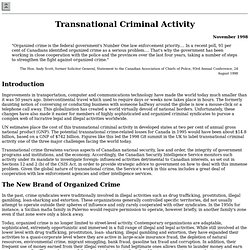
In a recent poll, 91 per cent of Canadians identified organized crime as a serious problem.... That's why the government has been working in close cooperation with the police and the provinces over the last four years, taking a number of steps to strengthen the fight against organized crime. " The Hon. Andy Scott, former Solicitor General, Statement to the Canadian Association of Chiefs of Police, 93rd Annual Conference, 24 August 1998 Introduction Improvements in transportation, computer and communications technology have made the world today much smaller than it was 50 years ago. UN estimates place the cost of this transnational criminal activity in developed states at two per cent of annual gross national product (GNP). Transnational Criminal Organizations: Strategic Alliances.
Transnational Criminal Organizations: Strategic AlliancesPhil WilliamsThe Washington Quarterly 1994 I Introduction Organized crime has traditionally been seen as a domestic problem bedeviling a relatively small number of states such as Italy, the United States, and Japan.
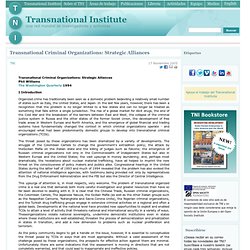
In the last few years, however, there has been a recognition that the problem is no longer limited to a few states and can no longer be treated as something that falls within a single jurisdiction. The threat posed by these organizations has been dramatized by a variety of developments. This upsurge of attention is, in most respects, very welcome.
As the policy community begins to get a handle on the issue, however, it is essential to conceptualize the threat posed by TCOs in ways that are most appropriate. Part of the problem is a form of threat inflation that, paradoxically, ends up under-estimating the threat. Such complexity is not fully captured by labels such as global organized crime or "Pax Mafiosa". II. Organized Crime. English | Français.
